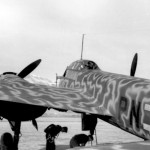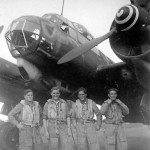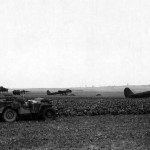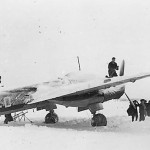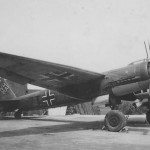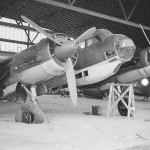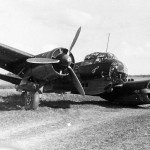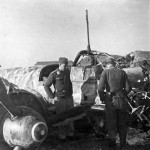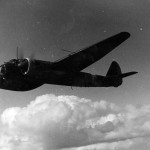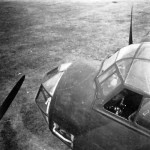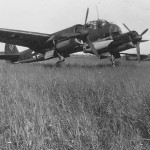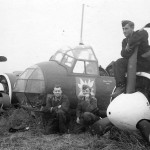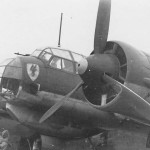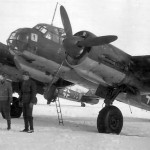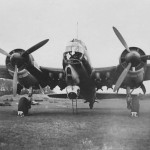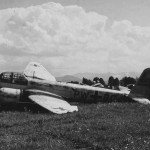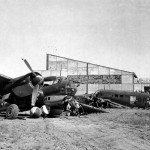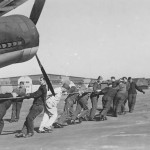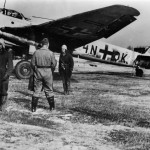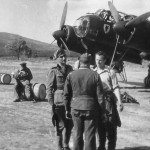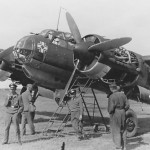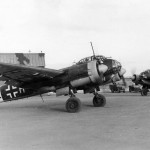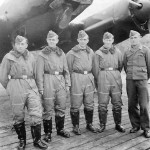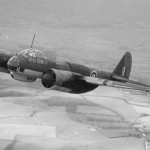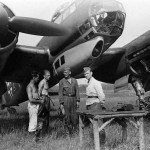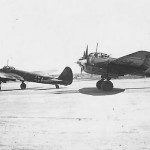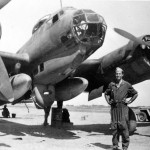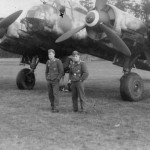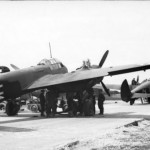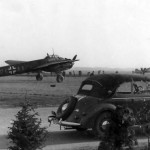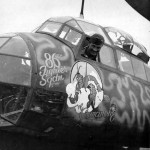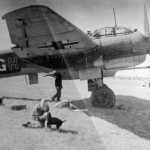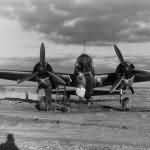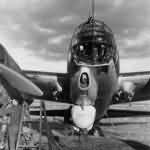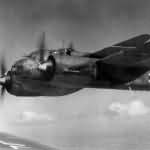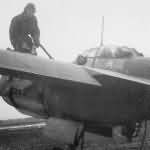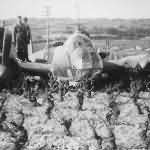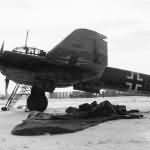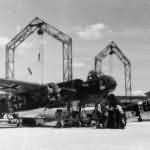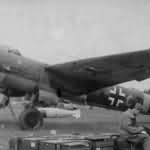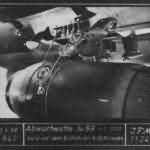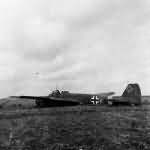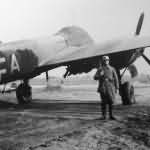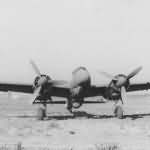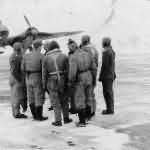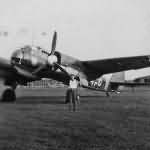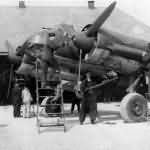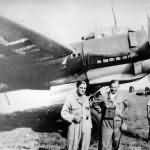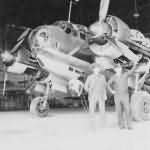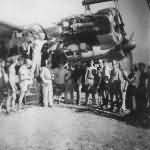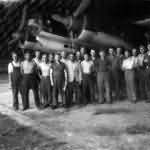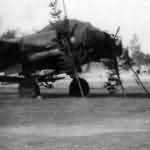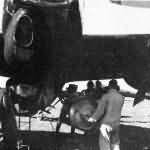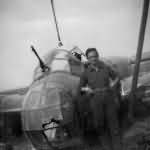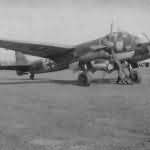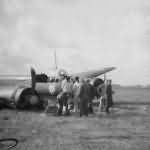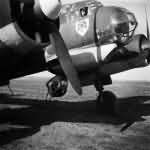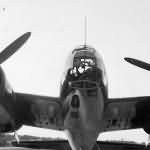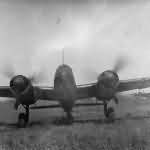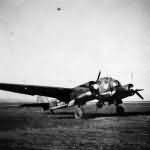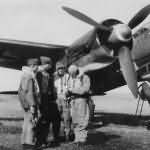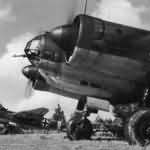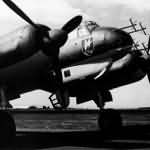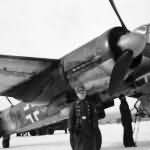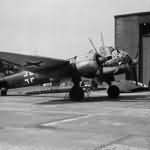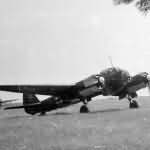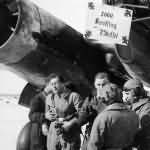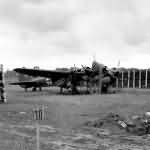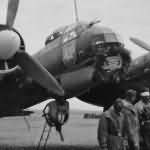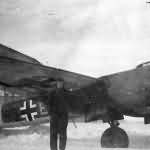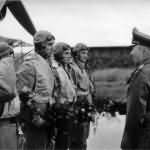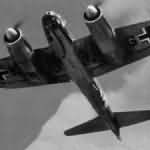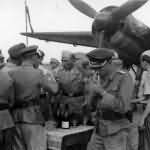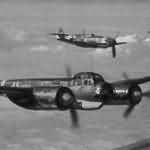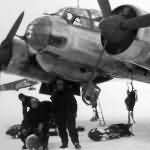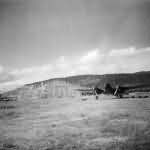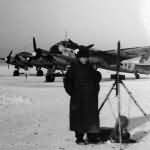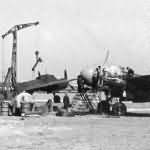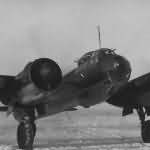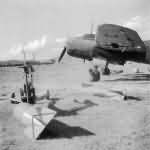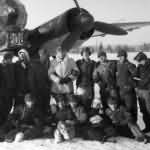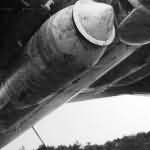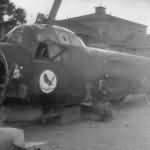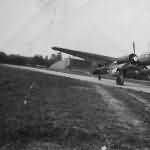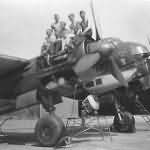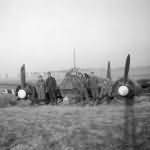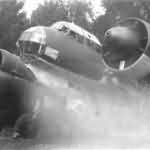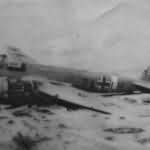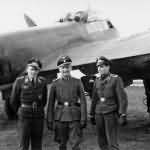Crashed Ju88 A1 of the Kampfgeschwader 54 “Totenkopf”, 1940-1941
5th Army Soldier Hangs Laundry on Wrecked German Ju88 1944 Italy
Junkers Ju 88 Catania Sicily Italy
Luftwaffe crew atop a crashed Junkers Ju 88 A from 1/KG 30
Junkers Ju 88 PN+M? in wellenmuster camouflage Italy
Junkers Ju 88 of the KG26 “Löwengeschwader” in flight
Ju 88 A of IV/KG 30 in Aalborg 1943
Dummy Ju88 Epinay airfield France September 1944
Junkers Ju 88A coded 5K+H? of the KG 3 “Blitz” on the ground
Junkers Ju 88 on the snow-covered airfield 1941-1942
Ju 88 A of II/KG 30 Amsterdam Schiphol Summer 1940
Ju 88 A from I/KG 77 with wellenmuster camouflage, 1943
Junkers Ju 88 7T+ Kustenfliegergruppe 606 in Holland 1940
Captured Ju88 and Fw190 England April 1944
dummy Ju88 France
Ju 88 in Briansk Russia
Crashed Ju88 C of the unknown Nachtjagdgeschwader, France
Damaged Ju88 in a hangar
Crashed Ju88A of the Kampfgeschwader 1 „Hindenburg“
Junkers Ju 88 G +MR wreckage
Ju 88 A I/KG 77 with FuG 200 Hohentwiel 1943 2
Junkers Ju88 in flight during World War II
Ju 88 A-5 code 3Z+GT of the 9/KG 77 1940
Ju 88 G-1 code D5+AF of Stab IV/NJG 3 – pilot Berthold Ney Jever 1945
Junkers Ju 88 and Fw189
Junkers Ju 88 III/KG 51 Edelweiss
Ground crew prepare a Ju 88 of KG54 to take off
Ju 88 A of II/KG 30 Amsterdam Schiphol 1940
Junkers Ju 88 assembly line
Junkers Ju 88 L1+AA of the LG1 in flight
Ju 88 P-1 from Versuchskommando für Panzerbekämpfung armed with single 75 mm “Bordkanone BK 7,5 cm” gun in gun pod
Bomber Junkers Ju 88A from Kampfgeschwader 1 in flight
Ju 88 C of the 2/NJG 2 in Benghazi Berka, Libya 1942
Junkers Ju88 code 7A+EH of 1/Aufklarungsgruppe 121
Bomber Junkers Ju88 A
Junkers Ju 88A. Bomber belonging to KG 54 “Totenkopf”
Ju 88 A of I/Kampfgeschwader 77 Catania, Italy
Ju 88 A-1 or A-0 of II/KG 30
Cockpit and gunner position of the Junkers Ju 88 A
Junkers Ju 88 G-1 WNr 714811 PW+BC May 1945 Bad Abling
Junkers Ju 88 code 7A+LH Aufklarungsgruppe 121 Africa
Junkers Ju 88 and Ju52 9P+HS of Kampfgruppe zbV 9 Tunisia
Ju 88G Night Fighter somewhere in Germany 1945
Junkers Ju 88 R code 2N+MH of the 1/ZG 1 8 May 1944 Marsaille Marignan
Ju 88 A code 7T+BH of 1/KGr 606 Ansbach 1941
Junkers Ju 88 D-1 and crew
Canopy and rear gunner’s position of the Junkers Ju 88
Heavy fighter Ju88 C
Junkers Ju 88 coded 4N+OK of Aufklarungsgruppe 22 (22nd Reconnaissance Group)
Ju 88 A of I/KG 77 crew Catania
Junkers Ju 88 A-5 of 7/KG 30 Adler Italy 1943
Junkers Ju 88A of the Kampfgeschwader 30 at Sicily, 1943
Ju 88 C-6 of the 2/NJG 2 Kassel Rothwesten Airfield 1944
A reconnaissance aircraft Ju 88 D of the 3/F 22, June 1941
British Ju 88 A-6 6073 HM509 of No 1426 Enemy Aircraft Flight (“Rafwaffe”)
Junkers Ju 88 A code L1+H? of LG 1 taxi after landing
Junkers Ju 88 of the KG 55
Wreckage of Junkers Ju 88 G-1 +FR from 7/NJG 4, Germany 1945
Ju 88 A of II/KG 30 Amsterdem Schiphol 1940
British Ju 88A-6 in flight over England. It was repainted with British identification markings
Captured by US forces Ju88 A-4 WNr 300227, code PI+SU, Italy 1943
Ju 88 with 2 x 1000 kg Bombs Italy
Captured by US forces Junkers Ju 88 of the 86th FS, 79th FG, Italy 2
Ju 88 A of I/KG 77 Catania 1942-43
Junkers Ju 88 crew 2
Junkers Ju88 A front view
Junkers Ju 88A
Junkers Ju 88 C-4 R4+AA of the Stab/NJG 2, pilot Maj Karl Hulshoff 1941
Junkers Ju 88 bombers
Ju 88 C of 3/NJG 2 in Derna or El Daba, North Africa 1942
Junkers Ju 88 Aufklarungsgruppe 33 in flight France
Junkers Ju88 P with 75 mm gun
Captured by U.S. forces Junkers Ju 88D-1 430650 with USAAF drop tanks
Ju 88 A-5 code 3Z+GT of the 9/KG 77 Battle of Britain 1940
Junkers Ju 88 P-1 from Versuchskommando für Panzerbekämpfung, 1943
Junkers Ju 88 A-4 5K+FN of the 5/KG3 Eastern Front 1942
Junkers Ju 88 of KG 1 with camouflage for night attacks over England
Junkers Ju 88 and crew 2
Wrecked night fighter Junkers Ju88G somewhere in Germany
Junkers Ju 88 code 7A+LL of the Aufklarungsgruppe 121
Ju 88A 3Z+?H of the 1/KG 77 on the ground, September 1943
Ju 88 C-2 cockpit interior. (Z)/KG 30, Norway 1940
Junkers Ju 88 night camo France
Junkers Ju 88 G-1 of the NJG 2. Aircraft was totally destroyed by fire.
Junkers Ju 88 G-6 623388
Ju 88 A 3Z+ KH 1/KG 77 with torpedo September 1943
Junkers Ju 88 code L1+AA LG1
Junkers Ju 88 Bomber code 7A+LH Aufklarungsgruppe 121 in African Desert
Ju 88 C-6 F8+HX of 13/KG 40 Cognac 23 December 1942
Ju 88 C-6 code R4+AA from Stab NJG 2 Maj Karl Hulshoff 1941
Captured Ju 88 with wellenmuster camouflage 86th FS 79th FG Italy, 1943
Junkers Ju 88 T5+GL of 3/Aufklarungsgruppe ObdL
Main landing gear of the Ju 88A being serviced
Flugzeug Junkers Ju 88 in flight
Crashed bomber Ju88
Ju 88 A V4+IU and V4+BU of 10/KG 1 Stara Bychow July 1942
Junkers Ju88 Nachtjager with Radar FuG 202 Lichtenstein winter
Ju 88 inght photo France
Captured night fighter Ju88 G-6
Ju 88A code L1+GT from 9/LG 1 captured at Derna Libya, North Africa 1943
Ju88 P-1 code “+GH” from Versuchskommando für Panzerbekämpfung with 7,5 cm Panzerabwehr Kanone
Bomber Junkers Ju 88 A +ZA at an unidentified airfield
Ju88 A L1+GH of 1/LG 1 North Africa 1942
Junkers Ju88 of the KG 76 coded F1+DT
Luftwaffe mechanics servicing a Ju88, code F1+DT of the KG76 Russia
White Ju88 of the KG 76 code F1+HS
Junkers Ju88 code 3Z+FU of the KG77 in flight
Junkers Ju88 medium bomber 3
Ju 88A on the ground, Eastern Front
Ju88A of the II Gruppe Kampfgeschwader 3 “Blitz”
Maintenance crew working on Ju 88, 1941-1942
Ju88 rear view winter in Russia
Junkers Ju88 medium bomber 7
Ju88 bombers in flight
Junkers Ju88 medium bomber 9
Junkers Ju88, medium bomber in standard Luftwaffe camouflage of the period
Junkers Ju88 medium bomber 6
Ju88A at a captured Soviet airfield, Eastern Front
Junkers Ju88 medium bomber 8
German medium bomber Junkers Ju 88 coded PI+HV
Ju88 bombers 3
Ju88 bomber KG51
Junkers Ju 88 A-6 Balloon Cutter
Frozen Junkers Ju88A of the KG51 “EDELWEISS”
Luftwaffe mechanics servicing a Ju 88 bombers of the KG 77 Italy
Bombing-up Ju88A with SD1000 bomb
Junkers Ju88A Werke Nr 4136 of I/KG 77 shot down 3rd October 1940
Junkers Ju88 medium bomber 2
Junkers Ju88 medium bomber 4
Junkers Ju88A of the KG51, coded 9K+CT on the ground
Junkers Ju88A, German medium bomber
Crashed German medium bomber Junkers Ju 88A
Ju88 and SC 1000 bomb
Ju88 of the Aufklarungsgruppe 10
Bomber Ju88 with camouflage for night attacks over England, Beauvais France
Heavy fighter Ju88 C-6 on the ground
Wreck of Junkers Ju88 from Wekusta 26, unit used for weather reconnaissance, 1941
Ju88 with wellenmuster camouflage
Luftwaffe Ju88 bombers
German bomber crews have a chat before going on a mission
Ju 88 A-0 or A-1 loaded wit bombs 4 X SC 250 KG, France 1940
Ju 88 A-0 or A-1 Winter 1939
Ju88 KG51 Edelweiss bomber, code 9K+CM
Luftwaffe mechanics servicing a bomber Junkers Ju88
Junkers Ju88 bomber
Ju88 Amiens France 1940
Ju88G night fighter with Schrage Musik, Germany 1945
Ju 88A-0/A-1 WNr 3065 KG51 Edelweiss West front 1940
Mechanics overhaul the engine of Junkers Ju 88
Ju88 luftwaffe bomber
Early Junkers Ju 88A in Creil 1940
A wrecked German night fighter Ju88G Germany 1944-45
Ju88 luftwaffe ceremony
Camouflaged Junkers Ju 88 of the Kampfgeschwader 76
Ju88 A – groundcrew load up a bomb on the underwing racks
Ju88 nose
Ju 88A from KG51 Edelweiss parked at an unidentified airfield
A crash-landed Junkers Ju88
Destroyed Junkers Ju88A from KG 76
Ju88 in Greece
Two soldiers inspect badly damaged Ju 88A following a forced landing
Junkers Ju88
Captured night fighter Ju88 G-1 W.Nr. 714084, 1945
Ju88A was forced for an emergency landing in field
A crash-landed Junkers Ju88 from KG 51 “Edelweiss”
Junkers Ju88 of the Flugzeugführerschule C 8 (FFS C 8)
Junkers Ju88 bomber
Junkers Ju 88 A4
Junkers Ju88 and crew of Luftwaffe weather reconnaissance unit Wekusta 26
Ju88 III/KG76 Heildelberg 38
Heavy fighter Ju88 C ready for take off
Junkers Ju88 bomber
Ju88 with FuG 200 Hohentwiel
Ju88 of the 2/KuFlGr 106 marking
Ju88 with Aufklarungsgruppe 121 marking
Luftwaffe Ju88 taxis at the airfield on Eastern Front, color photo
Ju 88A ready for take off, color photo
Night fighter Ju 88 of the NJG3, color
Junkers Ju 88D1 – long-range photo-reconnaissance variant
Luftwaffe Junkers Ju88
Crashed Junkers Ju88 coded V4+KE of the KG1, winter
Junkers ju88 kampfgeschwader 51 winter
Junkers Ju88 color photo
Ju 88 at a captured Soviet airfield
Ju88 Wintertarn mit Besatzung 2000 Feindflug Russia
Ju88 at Villacoublay Airfield, France September 1944
Ju88A from Kampfgeschwader 51 “Edelweiss”
Ju 88A at Kirowograd, Eastern Front 1943
Junkers Ju88A of the KG54, winter
Ju88 color photo ww2 bomber
Ju88 nachtjager color photo
Ju88 night fighter of the NJG6 with Wellenmuster wave pattern camouflage
Ju88 crew at Shipol airfield Amsterdam Holland 2000 missions 1943
Ju88 bomber Creil France 1941
Junkers Ju88 color photo 3
Junkers Ju 88 and crew
Ju 88 bomber crash at airfield
Ju88 after 4000 unit sortie, pilot Oltn Hessinger Italy 1943
Ju88A and Bf109 in flight, color photo
Junkers Ju88 under repair, North Africa 1941-1942
Junkers Ju88 color photo 2
Ju88 bomber color photo
Ju88 VW Kubelwagen Agais Aufklarungsgruppe 2(F)/123 1943
Ju 88 receiving maintenance before take off Winter Russia
Ju 88 bomb
Ju88 Winter Ostergruss Dno Russia 1942
Ju88 Banak Norway 1940
Ju 88 bomber Winter camo Russia
Luftwaffe mechanics servicing a Junkers Ju88 bombers
Junkers Ju88 KG51 color photo
Ju 88 Besatzung RK Trager Ernst Sorge 200 Feindflug
JU88 bomber at Banak airfield Norway 1940. Engine and canopy are covered with a tarpaulin to protect it against the weather.
The crew of this Ju 88 celebrate their 200th flight
Junkers Ju88 color photo 10
ju88 crew after 200 missions
Junkers JU 88 bomb
Ju 88A color photo, Eastern Front
JU 88A crashed and flipped onto its back at Pleskau Russia
Pilot stands with his crew in front of their Ju 88. Their unit has completed 500 operational sorties.
Junkers Ju88 of the Stab II/KG 3
Junkers Ju88 luftwaffe bomber
Junkers Ju88 photo
Junkers Ju88
Luftwaffe mechanics servicing a Junkers Ju88
KG30 “Adler” ground crews check their Ju88
Junkers Ju88 luftwaffe bomber
Junkers Ju88 luftwaffe
Junkers Ju88
Luftwaffe mechanics servicing a Ju88A in Kreta
Junkers Ju 88 coded 7A+LH of the 1(F)/121, North Africa
Luftwaffe mechanics servicing a Junkers Ju88 Kreta
Crew and their Ju88A belonging to an unidentified Luftwaffe unit
Junkers Ju88 code +HM, Luftwaffe pilots and SS man
History
Conceived in 1935 in response to an official requirement for a high speed medium bomber, the Junkers Ju 88 was to become the most versatile and widely produced German bomber of World War II. Although far from being the only German aeroplane to perform tasks for which it was not originally intended, few were “misemployed” with such success. The prototype Ju 88 V1 dew just before Christmas 1936, only eleven months after design work commenced, being powered by a pair of 900 hp Daimler-Benz DB600 inline engines in annular cowlings. The next year or two saw the completion of further prototypes and as with many other Luftwaffe aircraft of this period — a World record or two by the new aeroplane. Production of the first bomber series commenced in, 1938, and Ju 88 A-l, together with the few A-0 pre-production machines, were in service at the outbreak of war. The Junkers Ju88 A-1, the generally similar Ju88 A-2 and the Ju88 A-3 trainer all had a wing span of 18,25 m but this and several other details were modified, in the light of operational experience, in the Ju 88A-4. The span was increased by 1,8 m, considerable extra gunnery was installed, the bomb load was almost doubled. Many later A sub-types were completed, including the A-5 (produced before the A-4 but having the same wing and bomb load), the A-8 with balloon cable cutter, the A-12 dual control trainer, the A-13 ground attack and the A-17 torpedo bomber. Parallel with production of the A series, Junkers developed the Ju 88B around a pair of Jumo 213As; this series did not achieve full production, though the new nose of the B-1 was reflected in the tater Ju 188, for which another B sub-type acted as prototype. In order to maintain performance of the Ju 88 against that of later designs, Junkers engineers began an extensive reorientation in the middle war years, from which emerged the Ju 88S bombers. Powered by two BMW 801G radial engines of 1700 hp each, the S-1 featured a smoothly rounded nose, no gondola and drastically reduced bomb load and defensive armament. Junkers Ju88 S-2 and S-3 were generally similar except for engine and gunnery changes and a bulged bomb bay in the S-2. Altogether more than 9,000 bomber versions of the Ju 88 were built.
Parallel with the development of the Junkers Ju 88 as a medium bomber, the type was also being adapted to a variety of other roles, particularly those of night fighter, close support and reconnaissance. Approximately 6000 non bomber versions of the Junkers Ju 88 were built, and the length and diversity of this aeroplane’s career make an interesting comparison with the British de Havilland Mosquito. The first Junkers Ju 88 fighter to enter series production was the Ju 88C, comparable with the A bomber and powered by Jumo 211 inline or BMW 801 radial motors. Junkers Ju 88 C-1 featured the shorter span wing of the early Ju 88 A, but from the C-2 onwards the extended wing of the Ju 88 A-4 was employed. The early Ju88 C carried a crew of three and an armament, in a solid nose, of three 7.9 mm. machine guns and one 20 mm. cannon, with two further 20 mm. cannon in a detachable mounting below the nose. From the Ju88 C was developed the Ju 88G, a specialist night fighter carrying an additional crew member, which entered service in 1944. Another parallel to the Ju 88 A-4 bomber appeared as the long range reconnaissance Ju 88D-1, with fuel and cameras in the bomb bay and further fuel in undenving drop tanks. Altogether, nearly 2000 Ju 88 D-1, -2 and -3 aircraft were built. Another long range model was the Ju 88H, both the H-1 (reconnaissance) and the H-2 (fighter). Several Ju 88H aircraft ended their days as the lower half of a Mistel composite, with a Bf 109 or Fw 190 fighter on top of the fuselage. The ubiquitous Ju88 A-4 lent itself to yet another specialised development in the Ju 88P anti-tank aircraft which carried a heavy calibre cannon (two smaller ones in the case of the Ju88 P-2) in a special housing under the fuselage. The final photographic reconnaissance variant, the Ju 88T, was a development of the S bomber.
Total production: 15 183.
Variants
“A” – Bombers
A-0 – Pre-production series of 10 bombers for testing
A-1 – Initial production variant similar to the A-0
A-2 – A-1 with attachments for Walther Rb 202 R-Geräte booster rockets under the wings
A-3 – trainer A-1 fitted with double control columns, throttlequadrants and partially with double instrument. No armament.
A-4 – The major variant produced in the highest numbers. The wing span was extended by 1.62 m (5 ft 4 in) to improve handling, and the undercarriage was strengthened to permit the carriage of heavier loads. VDM metal propellers replaced by wooden VS-11. Mass balance fitted in top of redesigned rudder. Armoured pilot’s seat and light armor protection of cockpit. The aircraft had a new antenna mast, FuG 25a identification device, EZ-G Peil-Geraet radio direction finder (in top of rear fuselage) and FuG 101 altimeter. Asymetric bulged engine fairing applied and extra air intake in the lower portion of the front ring- shaped cooler.
A-4/torp – torpedo bomber with PVC 1000B launchers for two LT F5b torpedoes
A-4/trop – A tropicalized version of the A-4 with specialized equipment including extra water tanks sun and mosquito protection gear.
A-5 – A-1 fuselage with longer wings (20.08 m) and other equipment. Powered by Jumo Jumo 211B-1, G-1 or H-1 engines all rated at 1,200 hp (895 kW) for take-off.
A-6 – A-5 equipped with a balloon cable fender “Kuto-Nase”. The installation weighed 322 kg. A 58 kg counterweight was mounted in the rear fuselage. Extremely vulnerable to fighter interception because “Kuto-Nase”. reduced speed by 30-32 km/h (20 mph). Most aircraft reverted to the normal bomber A-5 version.
A-6/U – retired A-6 converted for the maritime role with Jumo 211J engines and FuG 200 “Hohentwiel” radar. Also equipped with FuG 217 “Neptun” warning radar, 900l external fuel tanks. Crew were reduced to 3 and ventral cupola was removed.
A-7 – Dual control trainer based on the A-5, not armed.
A-8 – A-4 with Kuto-Nase balloon cable cutters fitted to the wings. Crew were reduced to 3. Later converted to the normal bomber version powered by Jumo 211J
A-9 – tropicalized A-1 fitted with desert survival equipment (Increased rations of water, tent and rifles), sand filters on air intakes and sun blinds.
A-10 – tropicalized A-5
A-11 – tropicalized A-4 similar to A-10
A-12 – trainer based on the A-4 with dual control. Ventral gondola, dive brakes and all armament removed.
A-13 – new A-1 and converted A-4s for low level assault. Dive brakes and bomb sight removed. Additional armor for crew, engines and fuel tanks. Under the center wing section could be attached (2 or 4) AB 250. AB 500 or AB 1000 pods with 2kg SD2 anti-personnel bombs. Also fitted with WB-81A (3xMG81Z), WB 81B (3 x MG81Z with the muzzles pointing down at 15°) and ZWP 151/20 (2 x MG 151/20 cannons) gun-pods.
A-14 – fitted with a fixed forward-firing 20-mm MG FF cannon (120 rounds) in the ventral gondola, more armor for the crew, engine and fuel tanks. Dive brakes removed.
A-15 – One A-4 with enlarged wooden bomb bay, capable of holding 3290 kg of bombs. Ventral gondola removed, crew were reduced to 3.
A-16 – Trainer based on the A-14 with doubled instruments and control wheel. Armament, ventral cupola and dive brakes removed
A-17 – Torpedo bomber based on A-4 without ventral gondola. One PVC torpedo rack under each wing replaced the two bomb racks. Aircraft carried two LT F5b or F5w torpedoes. A long housing on the starboard side of the nose contained the torpedo aiming mechanisms. Crew reduced to three. Some A-17s were equipped with the FuG 200 “Hohentwiel” radar.
“B” – Prototype with all-new fully glazed nose
B – Prototype. A-1 with the more streamlined nose and larger wing span, developed into Ju188. Jumo engines replaced by BMW 801MA
B-0 – 10 pre-production aircraft with with lengthened forward fuselage and long wings of A-4. Used by 4,/ObdL in the long-range reconnaissance role.
B-3 – destroyer. Rb 50/30 or 20/30 cameras could be used for reconnaissance purposes.
“C”- heavy fighters, fighter-bombers and night fighters
C-0 – Heavy fighter, converted A-1 for tests
C-1 – Heavy fighter, 20 converted from A-1. Jumo 211 engines and glazed nose. Bombing and diving equipment removed.
C-2 – Heavy fighter 62 converted from A-1. Solid nose and Jumo 211B engines. Fuel tank or 500 kg bombs in bomb-bay.
C-3 – Heavy fighter, planned version with BMW801MA engines, none built
C-4 – Heavy fighter and reconnaissance plane based on A-4. Aircraft with the increased wing span, Jumo 211 F or J engines and FuBI 2 antenna under the fuselage. Sometimes fitted with two MG FF in ventral cupola. 130 built.
C-5 – 10 C-4 with BMW 801 D engines
C-6 – Heavy fighter and night fighter based on the A-4 bomber with a solid nose. Powered by Jumo 211J engines with 1420 hp and equipped with EZ-6 direction-finding FuG 101 radio-altimeter. FuBI 2 antenna moved forward.
Built in large numbers
C-6a – C-6 for daylight operations
C-6b – C-6 for night operations. Plane with flame concealing exhaust and without Fubl 2. Fitted with the FuG 202 Lichtenstein BC or FuG 212 Lichtenstein C-1 radar. Late aircraft with 2 x MG 151/20 Schrage Musik cannons mounted in the fuselage
C-6c – C-6b with the FuG 220 Lichtenstein SN-2 and FuG 227 Flensburg radar. Some equipped with FuG 350 Naxos Z
C-7a – C-6 for daylight operations with removed cupola. Gun pod with two MG FF under fuselage. 500 kg of bombs could be carried in the bomb bay.
C-7b – C-7a with underwing racks
C-7c – daylight powered by BMW 801MA
“D” – photo-reconnaissance variants
D-0 – long-range photo-reconnaissance variant based on A-5, built in the summer of 1940. External fuel tanks could be attached under the wings. Engines: Jumo 211 B-1, G-1 or H-1. Cameras mounted in central fuselage and dive brakes deleted.
D-1 – long-range photo-reconnaissance variant based on A-4 with Jumo 211J-1 or 2 engines. Could carry bombs or fuel tanks under the wings. The forward bomb bay was sealed off to house a extra fuel tank. Rear bomb bay accommodated two or three aerial cameras.
D-2 – long-range photo-reconnaissance variant based on A-5 with Jumo 211 G-1.
D-3 aka D-1/Trop – tropicalized D-1 with dust filters and extra equipment for the crew.
D-4 aka D-2/Trop – tropicalized D-2 similar to D-3
D-5 – based on D-1 with two cameras on the left side of the fuselage.
“G” – night fighters
G-0 – prototype for night fighter series with BMW801D and FuG 212 radar. Fuselage and undercarriage from R-2 without cupola under the cockpit. Tail section from the Ju188.
G-1 – Production series of the G-0 fitted with FuG 220 Lichtenstein SN-2 radar and only 4 MG 151/20 under the fuselage. Sometimes with “Schrage Musik” installation and extra FuG 217 Flensburg radar.
G-2 – experimental and similar to G-1. Jumo 213A engines and 30mm cannons
G-3 – G-1 with DB603 engines, not build
G-4 – G-1 with “Schrage Musik” as standard
G-5 – G-3 with Jumo 213A, not build
G-6a – G-4 with Jumo 213A engines with 1750 hp and wooden VS-11 propellers – designation never existed in reality
G-6b – G-6a with the FuG 350 Naxos Z radar – designation never existed in reality
G-6c – G-6a with FuG 218 Neptun and FuC 240 Berlin radars. Schrage Musik installation moved forward – designation never existed in reality
G-7a – G-6 with Jumo 213E high-altitude engines, MW 50 and outboard sections of the wings taken from the Ju 188 – designation never existed in reality
G-7b – G7a with FuG 228 Lichtenstein SN-3 or FuC 218 Neptun VR radars in a wooden nose housing – designation never existed in reality
G-7c – G-6 with a FuG 240 Berlin N-1a radar in a wooden housing, 10 built – designation never existed in reality
G-8 – A long range day fighter with fuselage from H-1. For Mistel project.
G-10 – similar to G-8 for Mistel programme.
“H” – Long-range photo-reconnaissance and fighters
H-1 – ultra long-range maritime reconnaissance variant powered by BMW 801D engines. A-4 fuselage lengthened to 17,75 m for extra fuel tank. Remotely controlled Robot Rb 70/30 and 50/30 cameras in the aft fuselage. Also fitted with FuG 220 Lichtenstein SN-2 radar. Only 10 bulit
H-2 – „Atlantikzerstörer“ ultra long-range fighter without radar operate against Allied maritime patrol aircraft hunting U-boats in the Atlantic. Armed with two MG 151/20 cannon in the closed nose and four in a ventral pod. Fuselage extended to 17.88m. Wing span extended to 20.08m. Only 5 bulit
H-3 – Ultra-long-range maritime reconnaissance variant similar to H-1 with tail from the G series. Fuselage with an additional section forward of the wing.
H-4 – long-range fighter variant similar to H-3.
“P” – tank and bomber destroyers
P-1 – modified to carry a single 75 mm Bordkanone BK 7,5 gun with an enlarged muzzle brake for low-altitude attacks on Russian tanks. Engine undersides and cockpit were armored. A few of these aircraft were tested in combat conditions on the Eastern Front
P-2 – heavy gun fighter variant with twin 37 mm Bordkanone BK 37 cannon in ventral gun pod. Ju 87 and Hs 129 equipped with the same weapon proved to be more suitable for anti-tank attacks. A few of these aircraft were tested in the ground attack role, and also against USAAF heavy bombers.
P-3 – similar to P-2 with with increased armor protection (cockpit, engine and armored windshield).
P-4 – similar to the P-1 with single 50 mm Bordkanone BK 5 gun in ventral gun pod.
P-5 – only proposed variant with single 88 mm gun
“R” – night fighters
R-1 – heavy fighter C-6 powered by BMW 801MA engines. Ventral cupola was removed. Equipped with FuG 212 and FuG 202 radars. Built in small numbers.
R-2 – heavy fighter C-6 powered by BMW 801D engines. Equipped with FuG 220 radar, FuG 25 identification device and FuG 16ZY.
“S” – High-speed bombers
S-0 – High-speed bomber based on A-4 powered by BMW 801D engines. Ventral cupola dive brakes and external racks were removed.
S-1 – Plane with more streamlined nose section and minimum of armor protection. Armament reduced to one MG131. Powered by BMW 801G-2 engines with the GM-1 system. Also fitted with dive brakes, external racks FuG 217 radar, FuG 25, FuG 16ZY and FuG 101 radio altimeter.
S-2 – similar to S-1 powered by turbo-supercharged BMW 801TJ engines with GM-1 injection. Fitted with enlarged wooden bomb bay for 3000 kg of bombs. In the rear of the bay were 2 fixed MG 81.
S-3 – powered by Jumo 213A engines with GM-1 and VS-111 propellers
S-5 – S-2 powered by Jumo 213T with turbosuperchargers, not build
“T” – photo-reconnaissance variants
T-1 – High-speed photo-reconnaissance variant of S-1 with Robot Rb 20/30, 50/30 or 70/30 photo cameras in the rear of the bomb bay.
T-2 – BMW 801J-0 engines with turbocharger. Not produced
T-3 – photo-reconnaissance variant of S-3
Specifications
variant | Ju 88 A-1 bomber | Ju 88 A-4 bomber | Ju 88 A-5 bomber | Ju 88 A-15 bomber, prototype |
crew | 4 | 4 | 4 | 3 |
wingspan (m) | 18,25 | 20,08 | 20,08 | 20,08 |
lenght (m) | 14,35 | 14,36 | 14,45 | 14,45 |
height (m) | 5,30 | 5,07 | 5,07 | 5,07 |
wing area (m2) | 52,50 | 54,70 | 54,70 | 54,7 |
gross weight (kg) | 7250 | 8550 | 8050 | 9000 |
normal take-off weight (kg) | 8958 | 12105 | ||
max take-off weight (kg) | 10360 | 14000 | 12450 | 12800 |
bombs (kg) | 2500 | 2400 – 3600 | 2500 | 3000 |
engines | Jumo 211 B-1, 1175 hp for take-off | Jumo 211 J-1 or J-2, 1410 hp for take-off (1060 hp at 5200m) | Jumo 211 G-1, 1200 hp for take-off | Jumo 211 J |
max speed (km/h) | 450 (at 5500 m and 8958 kg weight) | 470 (at 5300 m and 12490 kg weight) | 475 | 410 |
cruising speed (km/h) | 365 (at 0m) | 398 (at 5000 m) | 370 | 370 |
economical speed (km/h) | 349 (at 5500 m) | 370 (at 6000 m) | ||
landing speed (km/h) | 140 | 140 | 140 | 140 |
service ceiling (m) | 9800 | 8200 | 8500 | 8250 |
range (km) | 1500 – 1700 | 1790 – 2730 | 2950 | 2000 |
climb to | 5400 m / 23 m | |||
takeoff run (m) | 1800 | 1150 | 1800 | |
armament | 3 or 4 x MG 15 | 4 – 5 x MG 15, MG 81, MG 81Z + 1 z MG 131 | 5 x MG 81+ 1 z MG 131 | 3 x MG81 or MG15 |
radio equipment | FuG 16, FuG 25 | FuG 16, FuG 25 | FuG 16, FuG 25 |
variant | Ju 88 B-0 reconnaissance | Ju 88 C-4 heavy fighter | Ju 88 C-6 night fighter | Ju 88 D-1 reconnaissance |
crew | 4 | 3 | 3 | 4 |
wingspan (m) | 20,08 | 20,08 | 20,08 | 20,08 |
lenght (m) | 14,45 | 14,96 | 14,96 | 14,36 |
height (m) | 4,45 | 5,07 | 5,07 | 5,07 |
wing area (m2) | 54,70 | 54,70 | 54,70 | 54,7 |
gross weight (kg) | 9100 | 8000 | 9069 | 8480 |
normal take-off weight (kg) | 11450 | |||
max take-off weight (kg) | 12470 | 11350 | 12349 | 11490 |
bombs (kg) | 2500 | |||
engines | BMW 801 MA, 1560 hp for take-off | Jumo 211 F, 1420 hp for take-off | Jumo 211 J, 1410 hp for take-off (1060 hp at 5200m) | Jumo 211 B-1, 1175 hp for take-off |
max speed (km/h) | 540 | 495 | 488 – 494 (at 5300 m) | 475 |
cruising speed (km/h) | 510 | 485 | 449 (at 6000) | 425 |
economical speed (km/h) | 423 (at 6000) | |||
landing speed (km/h) | 175 | 140 | 145 | 140 |
service ceiling (m) | 9050 | 8600 | 9900 | 8600 |
range (km) | 2850 | 3050 | 1038 – 1980 | 2950 |
climb to | 6000 m / 12,7 m | |||
takeoff run (m) | 750 | 870 | 875 | 875 |
armament | 3 x MG 81Z | 1x MG15, 1x MG FF, 3x MG17 | 1x MG81 Z, 3x MG 151/20, 3x MG17 | 3 x MG 15 |
radio equipment | FuG 16, FuG 25 | FuG 16, FuG 25 | FuG 16, FuG 25 | FuG 16, FuG 25 |
variant | Ju 88 D-5 reconnaissance | Ju 88 R-2 night fighter | Ju 88 G-1 night fighter | Ju 88 G-6 night fighter |
crew | 4 | 4 | 4 | 4 |
wingspan (m) | 20,08 | 20,08 | 20,08 | 20,08 |
lenght (m) | 14,45 | 14,96 | 15,50 | 15,50 |
height (m) | 5,07 | 5,07 | 5,07 | 5,07 |
wing area (m2) | 54,70 | 54,70 | 54,70 | 54,70 |
gross weight (kg) | ||||
normal take-off weight (kg) | ||||
max take-off weight (kg) | 11300 | 11500 | 12100 | 12292 |
bombs (kg) | ||||
engines | Jumo 211 J, 1410 hp for take-off (1060 hp at 5200m) | BMW 801 D-2, 1700 hp for take-off | BMW 801 D-2, 1700 hp for take-off | Jumo 213 A, 1750 hp for take-off (1440 hp at 6000 m) |
max speed (km/h) | 480 | 580 | 540 | 533 – 538 (at 6000 m) |
cruising speed (km/h) | 430 | 510 | 480 | 510 |
economical speed (km/h) | ||||
landing speed (km/h) | 140 | 160 | 165 | 170 |
service ceiling (m) | 8700 | 9200 | 9400 | 9550 |
range (km) | 3100 | 3000 | 2800 | 2200 |
climb to | 6000 m / 11 m | |||
takeoff run (m) | 875 | 750 | 750 | 720 |
armament | 2 x MG 17 | 4 x MG 151/20, 1 x MG 81Z | 6 x MG 151/20, 1 x MG 131 | 6 x MG 151/20, 1 x MG 131 |
radio equipment | FuG 16, FuG 25, FuG 200 | FuG 220 | FuG 220 | FuG 220, FuG 227 |
| variant | Ju88 G-7 night fighter | Ju88 H-1 reconnaissance | Ju88 P-4 attacker | Ju88 T-1 reconnaissance |
| crew | 4 | 3 | 3 | 3 |
| wingspan (m) | 22,00 | 19,95 | 20,08 | 20,08 |
| lenght (m) | 14,54 | 17,65 | 14,36 | 14,84 |
| height (m) | 5,07 | 5,07 | 5,07 | 5,07 |
| wing area (m2) | 56 | 54,70 | 54,70 | 54,70 |
| gross weight (kg) | ||||
| normal take-off weight (kg) | ||||
| max take-off weight (kg) | 13109 – 13825 | 11400 | 12215 | |
| bombs (kg) | ||||
| engines | Jumo 213 E, 1750 hp for take-off (1608 hp at 9100 m) | BMW 801 D-2, 1700 hp for take-off | Jumo 211 B-1, 1175 hp for take-off | BMW 801 G, 1700 hp for take-off |
| max speed (km/h) | 626 – 647 (at 9100 m ) | 445 | 390 | 640 |
| cruising speed (km/h) | 590 | 410 | 370 | 570 |
| economical speed (km/h) | ||||
| landing speed (km/h) | 175 | 140 | 140 | 175 |
| service ceiling (m) | 9800 | 8500 | 8000 | 9800 |
| range (km) | 2220 | 5120 | 2000 | 1090 |
| climb to | 9200 m / 26,4 m | |||
| takeoff run (m) | 875 | 1250 | 1300 | 700 |
| armament | 6 x MG 151/20, 1 x MG 131 | 2 x MG131 or MG 81 | 2 x MG 81Z | |
| radio equipment | FuG 220, FuG 228 or FuG 240 | FuG 200 | FuG 16, FuG 25 | FuG 16, FuG 25 |
| Source: “Die Ju 88 und ihre Folgemuster” Heinz Nowarra | ||||




